This was published 5 years ago
The Rio Grande, Big Bend National Park, Texas: Borderland adventures US and Mexico
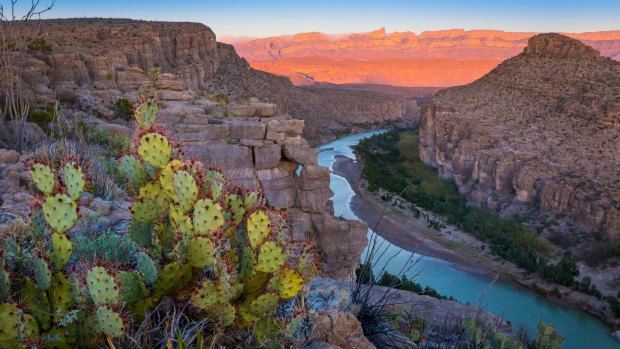
Big Bend National Park in Texas is the largest protected area of Chihuahuan Desert.Credit: Alamy
It is morning when we lower our rafts into the surging water of the Rio Grande in the Big Bend Ranch State Park in Texas. As we push off a red-tail hawk hovers overhead like a cardboard cutout against an enamel blue sky.
We are soon lassoed by the river, pulled along by a force and fury befitting its Mexican name – Rio Bravo. With two in front, two behind and our river guide in the middle we bucket along, paddling in and out of Mexico and the United States with an ease that would make President Trump's comb-over stand on end.
For a significant part of its 3034-kilometre journey the Rio Grande forms a natural border between the US state of Texas and Mexico, starting in the Colorado Rockies before emptying into the Gulf of Mexico. Technically, the deepest part of the river is the boundary, but like the birds and bears that call this wild place home, we pick our own path, oblivious to politics.
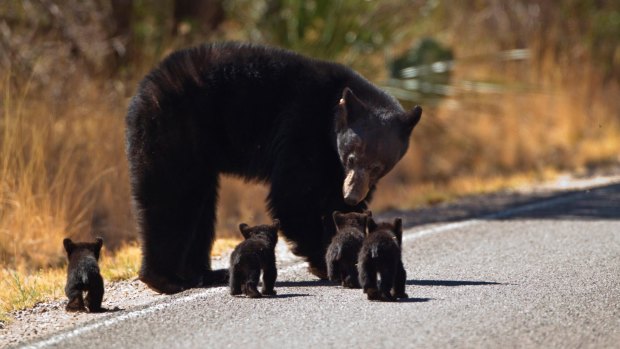
A black bear mother with her young in Big Bend National Park.Credit: Alamy
Rounding a bend the white water flattens as we enter Dark Canyon, one of eight slots along the state park, the slosh of water around our bow the only sound as we drift beneath 200-metre-high cliffs. "Some of these canyons can only be accessed by raft," says Erica Little, a river guide with Far Flung Outdoor Centre who has spent 11 seasons on the Rio Grande.
It is day three of my exploration of Big Bend Ranch Park and the adjoining Big Bend National Park, a 324,000-hectare swath of the Chihuahuan Desert where the Rio Grande makes its graceful arc around the Chisos Mountains.
As we drift Erica points out softshell turtles, their spiny projections looking like goosebumps, giant toads resting on rocks and peregrine falcons soaring high overhead. "The river is the lifeline of the Chihuahuan Desert," Erica says. "You'll find plants and animals here that are totally different to the rest of the park."
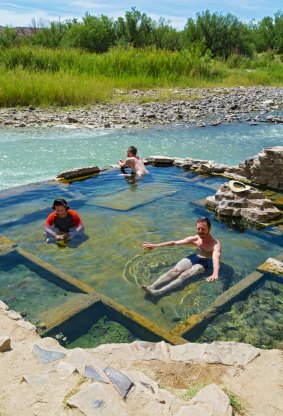
Boquillas Hot Springs, Big Bend National Park, Texas.Credit: Alamy
We haul out on a shaded, sandy section (I'm not saying which side) where we enjoy snacks and cool drinks before pushing on through another canyon. "This is a perfect river for novices," Erica says. "Lots of flat water and a few rapids to keep everyone happy."
I've been ridiculously happy since arriving in Big Bend; the 180-kilometre drive from Alpine taking me through the artists' enclave of Terlingua, past the desiccated Badlands, and finally to a screeching halt in front of two black bear cubs as they darted across the mountain road on dusk.
These sturdy bears were once common in the Big Bend region, but hunting and trapping lead to their demise by the mid-1940s. Thankfully, they still flourished on the Mexican side, and by the 1980s a few strong swimmers had crossed the Rio Grande and re-established a colony within the safety of the park.
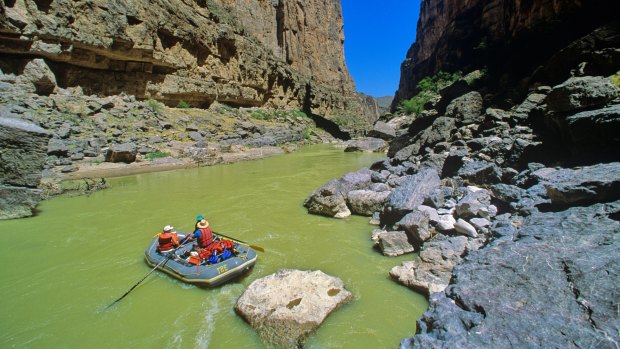
Rafting at Tight Squeeze on the Rio Grande in Mariscal Canyon.Credit: Alamy
I cheer as the two juveniles lumber past, their defiant existence further proof that a border wall would be an ecological disaster for this rich wildlife corridor. To my joy, every Texan I chatted to agreed with the same sentiment.
The sky is a cosmetic kit of pinks and greys, framed by the V-shaped canyon known as the "window", as I pull up at the Chisos Mountain Lodge, my comfortable base for the next two nights and only lodging within the national park.
By 8am the next morning I am on the Lost Mine Trail, an eight-kilometre round hike of medium difficulty, which will take about four hours. "By starting early we'll beat the heat," says guide Kara Gerbert. "What we don't have to worry about are crowds."
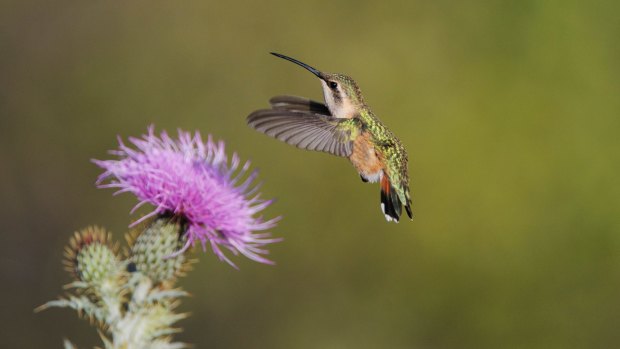
A Lucifer hummingbird feeding on Texas thistle, Chisos Mountains.Credit: Alamy
Park statistics show that more people visit the Grand Canyon during a single month than visit Big Bend during the course of a whole year. The well-defined trail is empty as we step past spiky succulents, the fireball sun a gleaming lantern burning in the treetops. I pause often, filling my journal with sketches and notes – tufted titmouse, beaked yucca, alligator juniper – words as flinty and alien as the landscape itself.
Kara points out the fierce-looking Agave lechuguilla, also known as the "shin-dagger", a species of agave found only in the Chihuahuan desert. Traversing a series of switchbacks we pause to catch our breath, gazing across Juniper Canyon, its buckled sides looking like a pleated skirt, while overhead a tiny titmouse calls out Peter, Peter, Peter. Thanks to the variety of ecosystems – mountains, dessert and river – 450 species of birds are found within the park boundaries.
You'd need weeks to explore it all – trekking the dozens of day and multi-day trails, camping out in the back-country – but my time is short, so I spend the afternoon driving a loop through the park.
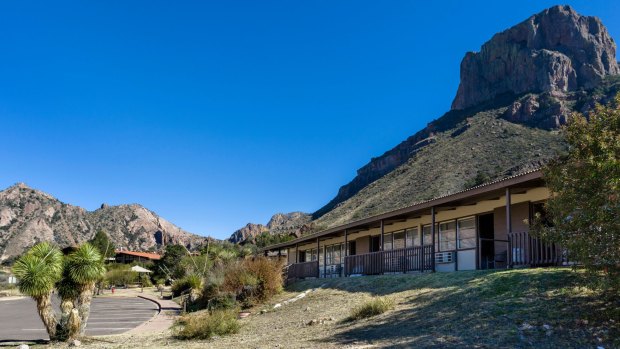
The Chisos Mountains Lodge, Big Bend National Park, Texas.Credit: Alamy
From the visitor centre I skirt the western side of the Chisos Mountains, stopping often to appreciate the sounds and solitude of a landscape born of fire more than 60 million years ago. Today the furrowed mountains are referred to as "sky islands", a series of peaks cloaked in maple, fir and aspen forests that rake the clouds.
Returning from a hike on a short trail I'm startled by the sudden appearance of two bristly javelinas. "Looks like a pig and smells like a skunk," is the local description. Still, better a pair of smelly herbivores than a hungry mountain lion, for which the region is known.
After reaching Santa Elena canyon, where the Rio Grande makes a hairpin bend, I head back to Panther Junction and Boquillas Hot Springs. With the place to myself I loll in the still blue waters, heated to a constant 37 degrees from deep under the earth where some of the original fire still burns. With a feeling of contentment I rest against the rocks, trailing one hand in the cool, coffee-coloured Rio Grande.
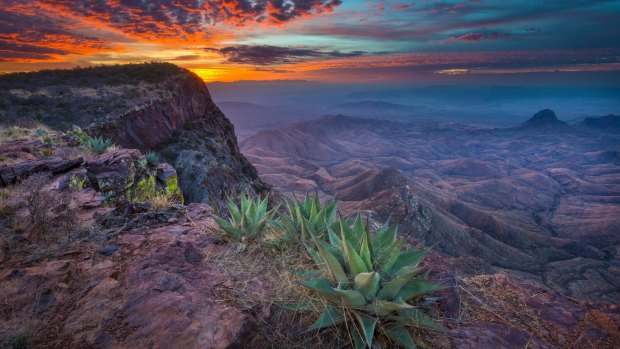
The view over Big Bend National Park in Texas.Credit: Alamy
Walking back to my car I spy a collection of hand-crafted, copper wire and bead animals tucked against a crevice, a rusted honour tin labelled "gracias" indicating that this is probably the makeshift stall of a needy Mexican. I exchange a few small notes for a purple roadrunner (quite possibly an illegal transaction), humbled by the thought that someone was desperate enough to cross these raging waters to earn a few tourist dollars.
It's my final morning when I drive west, following a portion of the infamous River Road alongside the Rio Grande into Big Bend Ranch Park. Visited by few and unknown even to most Texans, this is one of the last true frontiers, a borderland of furious extremes that challenges all who wander here.
Lowering our rafts into the turbulent waters I reflect on my good fortune; heaven for one person can be hardship for another, it all depends on what side of the squiggly line you find yourself on.
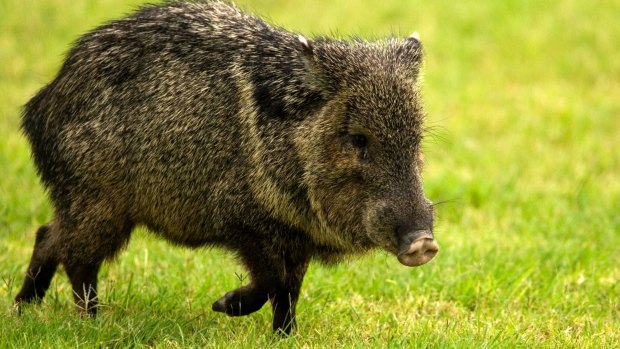
A javelina photographed in Big Bend National Park.Credit: Alamy
TRIP NOTES
MORE
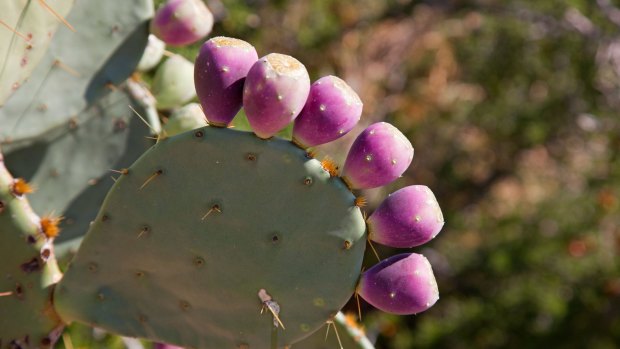
Fruit on a prickly pear cactus in Big Bend National Park.Credit: Alamy
TRAVEL
United Airlines flies daily from Sydney and Melbourne to Los Angeles. See unitedairlines.com
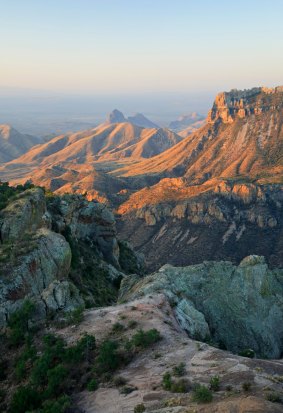
Rugged landscape from Lost Mine trail, Chisos Mountains.Credit: Alamy
Amtrak's Sunset Limited train connects Los Angeles with New Orleans, stopping at numerous cities including Alpine; seats with reservations start at $195 and upgrades to a superliner roomette starts from $A390 a person. See railplus.com.au or call 1300 555 003
STAY
Positioned inside the national park the Chisos Mountains Lodge exudes a rustic, outdoorsy air, with spectacular views over the Chisos Mountains. Rooms start from $US148 a night. See chisosmountainslodge.com
TOUR
Far Flung Outdoor Centre offers half-, one-day and overnight rafting adventures from their base near Study Butte. See bigbendfarflung.com
Kerry van der Jagt travelled as a guest of United Airlines, Rail Plus, Texas Tourism and Visit Big Bend.
Sign up for the Traveller Deals newsletter
Get exclusive travel deals delivered straight to your inbox. Sign up now.